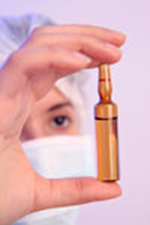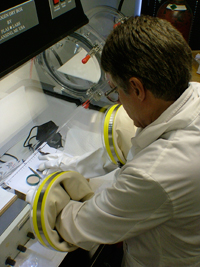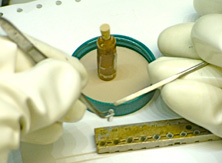Air Sensitive
 Air Sensitive Sample Analysis
Air Sensitive Sample Analysis
For an accurate evaluation of purity, air-sensitive samples require weighing under an inert atmosphere. Midwest Microlab maintains a reduced oxygen and moisture free handling system. Very highly hygroscopic samples many times will also benefit from this type of special handling. The glove box is operated with 99.9% EXTRA dry nitrogen. Purging is done under vacuum before any samples are handled. An oxygen monitor continually checks the internal environment for the presence of oxygen. NOTE: this monitor rarely shows a zero count. Though we continually strive for the best results, no inert chamber can be absolutely free of oxygen and/or moisture. Samples are therefore weighed as quickly as possible under these conditions. Every effort is made to secure the best possible measurement of elements requested. Experience has shown that samples that are able to withstand 15 sec exposure at 40 ppm oxygen work very well.
 The system also contains electrostatic reduction equipment to aid in handling. Samples weighed under inert atmosphere MUST be transferrable. These samples must be either liquids or solids.
The system also contains electrostatic reduction equipment to aid in handling. Samples weighed under inert atmosphere MUST be transferrable. These samples must be either liquids or solids.
Air sensitive handling at Midwest Microlab is limited to the following elements ONLY: Carbon, Hydrogen, Nitrogen, Phosphorous, and Fluorine. Please note the Air Sensitive Handling on your Submission Form.
We do NOT handle air-sensitive samples containing any of the following: Osmium, non-depleted Uranium, or Thallium.
 Shipping:
Shipping:
Small glass ampoules (see picture above) or compression sealed vials are the best ways to send these type of samples. This helps to eliminate any degradation in transit. Samples that are only slightly oxygen sensitive, can give good results when sealed tightly in screw cap vials. For these a second sealed outer vial should be included. As with all analysis, samples MUST be highly purified to achieve good results.
Note from our Senior Chemist,
One of the biggest problems in the analysis of air-sensitive samples is the amount(size) of the individual samples submitted. Accuracy greatly declines when transferring less than 2 mg of material.
Please recognize that powdery substances will almost always tend to adhere to glass vials and are not totally recoverable. The extremely dry atmosphere can also cause static to decrease the total transfer. A slight excess of sample is always preferable.
We always try to obtain the most accurate results with what is sent. This is rarely achieved when sealing less than the necessary amount of material. Many pure substances yield poor results when combusting low sample weights.
Please keep these ideas in mind when sealing up all samples for air-sensitive work. This is expensive and time consuming work. We strive to do our best in achieving accurate and precise measurements when processing your samples.




